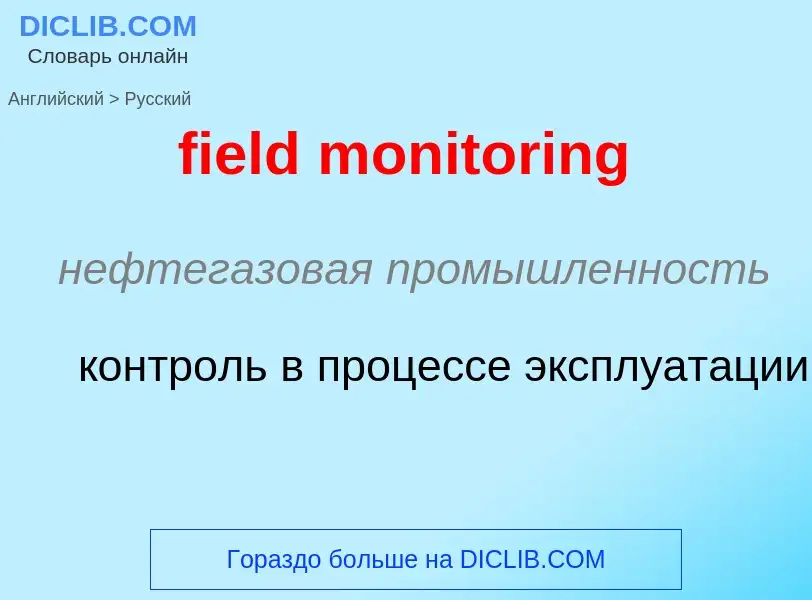Перевод и анализ слов искусственным интеллектом ChatGPT
На этой странице Вы можете получить подробный анализ слова или словосочетания, произведенный с помощью лучшей на сегодняшний день технологии искусственного интеллекта:
- как употребляется слово
- частота употребления
- используется оно чаще в устной или письменной речи
- варианты перевода слова
- примеры употребления (несколько фраз с переводом)
- этимология
field monitoring - перевод на русский
нефтегазовая промышленность
контроль в процессе эксплуатации
['mɔnit(ə)riŋ]
общая лексика
регистрация функций организма с сигнализацией об отклонениях от нормы
мониторинг
перманентный контроль
слежение (напр. за состоянием среды)
дозиметрический контроль
дозировка
слежение, контроль, мониторинг
контролирование
контролирующий
контроль
контроль подслушиванием
контрольно-выпрямительный
контрольный
коррекция гироскопа
подслушивание
проверка
управление
управляющий
медицина
дозиметрия
мониторное наблюдение
наблюдение
мониторирование
регулирование
строительное дело
контроль, мониторинг (непрерывное наблюдение переменной)
дистанционный диспетчерский контроль
нефтегазовая промышленность
текущий контроль
Смотрите также
существительное
общая лексика
контроль
подслушивание
радиоперехват
физика
дозировка
дозиметрический контроль
математика
алгебраическое поле
математика
топологическое поле
Определение
Википедия
In aviation, a balanced field takeoff is a condition where the takeoff distance required (TODR) with one engine inoperative and the accelerate-stop distance are equal for the aircraft weight, engine thrust, aircraft configuration and runway condition. For a given aircraft weight, engine thrust, aircraft configuration, and runway condition, the shortest runway length that complies with safety regulations is the balanced field length.
The takeoff decision speed V1 is the fastest speed at which the pilot must take the first actions to reject the takeoff (e.g. reduce thrust, apply brakes, deploy speed brakes). At speeds below V1 the aircraft can be brought to a halt before the end of the runway. At V1 and above, the pilot should continue the takeoff even if an emergency is recognized. The speed will ensure the aircraft achieves the required height above the takeoff surface within the takeoff distance.
To achieve a balanced field takeoff, V1 is selected so the take-off distance with one engine inoperative, and the accelerate-stop distance, are equal. When the runway length is equal to the balanced field length only one value for V1 will exist. Aviation regulations (for transport category aircraft) require the takeoff distance with one engine inoperative to be no greater than the take-off distance available (TODA); and the accelerate-stop distance to be no greater than the accelerate-stop distance available (ASDA).
On runways longer than the balanced field length for the aircraft weight the operator may be able to choose V1 from a range of speeds if adequate information is supplied by the aircraft manufacturer. The slowest speed in this range will be determined by the Take Off Distance Available (TODA). For a low V1, if an engine fails just above V1, the acceleration to VR on one engine will take more distance. Whereas, if an engine fails before a low V1, it will take less distance to stop, so the Accelerate Stop Distance Required (ASDR) is lower. By contrast, the fastest speed in this range will be determined by the Accelerate Stop Distance Available (ASDA). If an engine fails above a high V1, it will take less distance to reach VR, so Take Off Distance Required (TODR) is lower. Whereas, if an engine fails just below a high V1, it will take more distance to stop, so the Accelerate Stop Distance Required is greater.
Alternatively, on runways longer than the balanced field length the pilot can use reduced thrust, resulting in the balanced field length again being equal to the runway length available.
Factors affecting the balanced field length include:
- the mass of the aircraft – higher mass results in slower acceleration and higher takeoff speed
- engine thrust – affected by temperature and air pressure, but reduced thrust can also be deliberately selected by the pilot
- density altitude – reduced air pressure or increased temperature increases minimum take off speed
- aircraft configuration such as wing flap position
- runway slope and runway wind component
- runway conditions – a rough or soft field slows acceleration, a wet or icy field reduces braking

![genus]] two (two handles). The genus can be read off the field of meromorphic functions on the surface. genus]] two (two handles). The genus can be read off the field of meromorphic functions on the surface.](https://commons.wikimedia.org/wiki/Special:FilePath/Double torus illustration.png?width=200)
